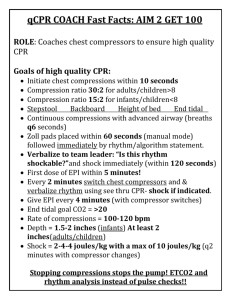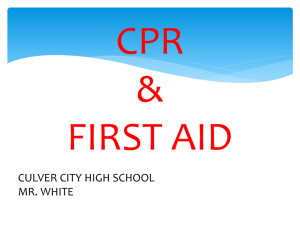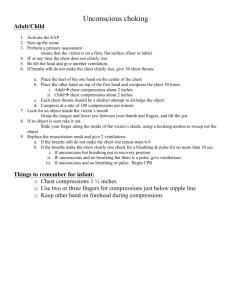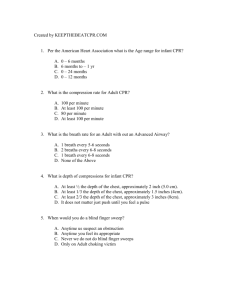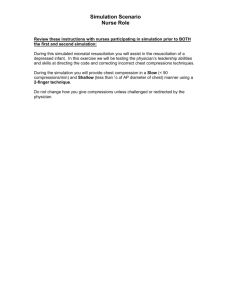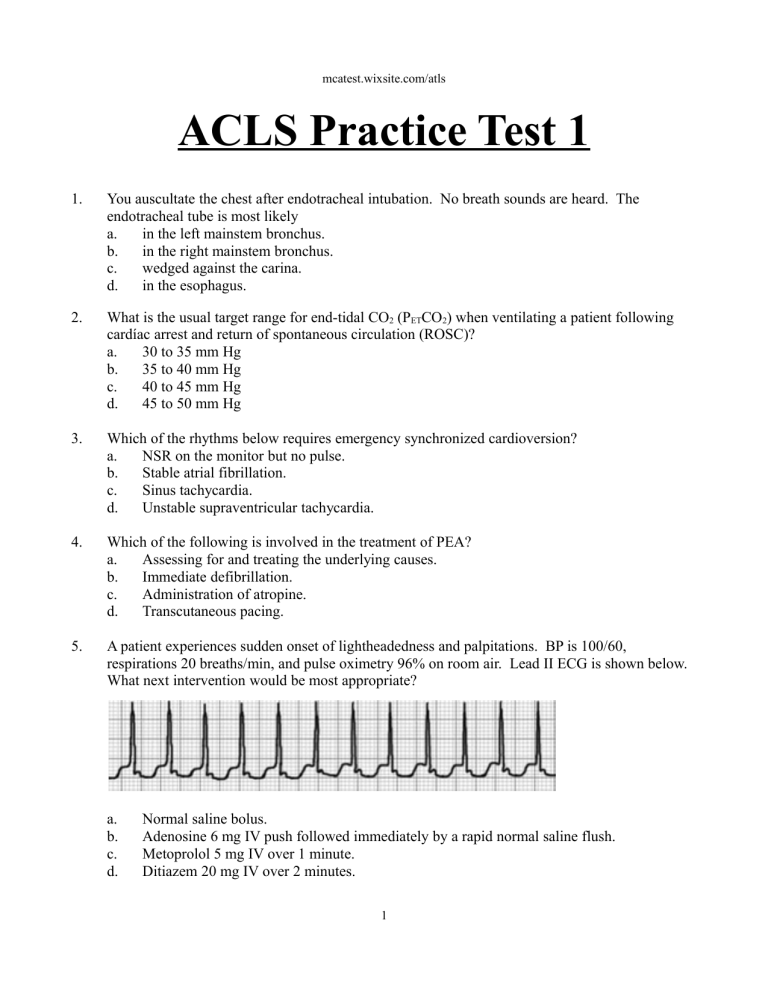
mcatest.wixsite.com/atls ACLS Practice Test 1 1. You auscultate the chest after endotracheal intubation. No breath sounds are heard. The endotracheal tube is most likely a. in the left mainstem bronchus. b. in the right mainstem bronchus. c. wedged against the carina. d. in the esophagus. 2. What is the usual target range for end-tidal CO2 (PETCO2) when ventilating a patient following cardíac arrest and return of spontaneous circulation (ROSC)? a. 30 to 35 mm Hg b. 35 to 40 mm Hg c. 40 to 45 mm Hg d. 45 to 50 mm Hg 3. Which of the rhythms below requires emergency synchronized cardioversion? a. NSR on the monitor but no pulse. b. Stable atrial fibrillation. c. Sinus tachycardia. d. Unstable supraventricular tachycardia. 4. Which of the following is involved in the treatment of PEA? a. Assessing for and treating the underlying causes. b. Immediate defibrillation. c. Administration of atropine. d. Transcutaneous pacing. 5. A patient experiences sudden onset of lightheadedness and palpitations. BP is 100/60, respirations 20 breaths/min, and pulse oximetry 96% on room air. Lead II ECG is shown below. What next intervention would be most appropriate? a. b. c. d. Normal saline bolus. Adenosine 6 mg IV push followed immediately by a rapid normal saline flush. Metoprolol 5 mg IV over 1 minute. Ditiazem 20 mg IV over 2 minutes. 1 mcatest.wixsite.com/atls 6. In the defibrillation sequence, which of the following is a safe and effective practice? a. Announce clear after you deliver the electric shock. b. Assess for a pulse immediately after the shock. c. Ensure there is no oxygen being blown over he patient's chest during the shock. d. Stop chest compressions while charging the defibrillator. 7. Which of the following is an indication for gastric lavage in patients who have ingested a toxin or who have overdosed on drugs? a. Comatose patients. b. Overdose of opioids taken 2 hours ago. c. Any lethal dose regardless of elapsed time. d. Within 1 hour of ingestion. 8. Regarding defibrillation, which action increases the likelihood of success? a. Providing quality chest compressions immediately before defibrillation. b. Using paddles with light pressure against the chest. c. Administering ventilations just prior to defibrillation. d. Pausing chest compressions right after defibrillation. 9. Supportive therapy for all suspected stroke patients includes: a. Administration of antihypertensives. b. Maintenance of airway and adequate oxygenation. c. Fibrinolytic therapy. d. Surgical clipping of an aneurysm. 10. After about 5 minutes of CPR, the ECG monitor shows the rhythm below. No pulse is detectable. IV access has been established and bag-mask ventilation is being performed with 100% oxygen. Which of the following should be the next step? a. b. c. d. Norepinephrine 0.02 to 0.2 mcg/kg/min IV infusion. Epinephrine 1 mg IV push. Insert an advanced airway. Atropine 0.5 mg IV push. 11. BLS includes which of the following? a. Therapeutic hypothermia. b. Administration of vasopressors. c. Advanced airway. d. Early defibrillation. 2 mcatest.wixsite.com/atls 12. An activated AED does not promptly analyze the rhythm. What is your next action? a. Turn the AED off wait 30 seconds then turn the AED on again. b. Await the arrival of emergency medical services. c. Check all AED connections and reanalyze. d. Rotate AED electrodes to an alternate position. 13. A patient presents with shortness of breath, lightheadedness, and sinus bradycardia at 42 beats/minute. An initial dose of atropine 0.5 mg IV was ineffective. You do not have transcutaneous pacing capability. Which of the following is a reasonable next step? a. Epinephrine 2 to 10 mcg/min IV. b. Amiodarone 150 mg IV. c. MgSO4 2 g IV. d. Adenosine 6 mg IV. 14. What is the recommended second dose of adenosine for patients in refractory but stable narrowcomplex tachycardia? a. 3 mg b. 6 mg c. 9 mg d. 12 mg 15. A pregnant patient in cardiac arrest should: a. be slightly tilted to the left or have her uterus displaced to the left, or both. b. have her head raised 30 degrees. c. not be defibrillated. d. be kept supine during chest compressions. 16. For a patient experiencing VF or pulseless VT, an alternative drug to epinephrine is: a. lidocaine b. amiodarone. c. vasopressin. d. atropine. 17. Which one of the following statements regarding bag-mask ventilation is false? a. In adults, bag-mask devices usually provide less ventilatory volume than mouth-to-mask ventilation. b. Ideal features of a bag-mask device include a self-expanding bag, pop-off valve, and transparent mask. c. Two people operating the bag-mask device, one to hold the mask to the patient's face and the other to squeeze the bag, is likely more effective than one person operating the device. d. A bag-mask device may be used with a mask, endotracheal tube, or any other advanced airway. 3 mcatest.wixsite.com/atls 18. An unresponsive, pulseless patient is receiving effective chest compressions and bag-mask ventilations. Defibrillator pads are applied and the rhythm below is displayed. The next step should be: a. b. c. d. start an IV and give epinephrine 1 mg IV. start an IV and give amiodarone 300 mg IV. synchronous cardioversion starting at 100 j. defibrillation at 200 j biphasic. 19. The correct sequence of actions in BLS is: a. Check for unresponsiveness, open airway, give 2 breaths, check for pulse, start CPR. b. Check for unresponsiveness, activate emergency services, get AED, check pulse for 5 to 10 seconds, if no definite pulse start chest compressions, give 2 ventilations after every 30 compressions, utilize AED as soon as possible. c. Check for unresponsiveness, open airway, give 2 breaths, check for pulse, start CPR checking for pulse every minute. d. Check for unresponsiveness, activate emergency services, check pulse for 30 seconds, if no definite pulse start chest compressions, give 2 ventilations after every 30 compressions. 20. A 56-year-old woman presents with severe chest pain, shortness of breath, nausea, and diaphoresis. She smoked 1 pack/day for the last 40 years. She took ASA 325 mg at home. You are giving her oxygen and her saturation is 98%. A cardiac monitor is attached and an IV started. Her BP is 150/94, pulse 92, respirations 24. Which of the following is most appropriate at this time? a. Obtain a 12-lead ECG to confirm the diagnosis before giving any medications. b. Give sublingual nitroglycerin, and if pain persists give morphine IV. c. Give morphine IV, and if pain persists give sublingual nitroglycerin. d. Administer a fibrinolytic. 21. All of the following are indicators of effective CPR, except: a. end-tidal CO2 (PETCO2) > 10 mm Hg. b. diastolic BP > 20 mm Hg. c. chest compressions ≥ 5 cm (2 inches), allowing for complete chest recoil, and at a rate of 80 compressions/min. d. minimizing the number of interruptions in CPR, with each interruption < 10 seconds. 4 mcatest.wixsite.com/atls 22. What is the minimum systolic blood pressure one should attempt to achieve with fluid, inotropes, or vasopressors in a post-cardiac arrest patient who achieves ROSC? a. 90 mm Hg b. 85 mm Hg c. 80 mm Hg d. 75 mm Hg 23. What is the recommended IV fluid (normal saline or Ringer's lactate) bolus dose for a patient who achieves ROSC but is hypotensive during the post-cardiac arrest period? a. 250 to 500 mL b. 500 to 1,000 mL c. 1 to 2 L d. 2 to 3 L 24. What is the most reliable method of confirming and monitoring correct placement of an endotracheal tube? a. 5-point auscultation b. Colorimetric capnography c. Continuous waveform capnography d. Use of esophageal detection devices 25. What is the potential danger of using ties that pass circumferentially around the patient's neck when securing an advanced airway? a. May interfere with effective ventilation b. Places the patient's cervical spine at risk c. Obstruction of venous return from the brain d. Does not adequately secure the airway device 26. Which condition is a contraindication to therapeutic hypothermia during the post-cardiac arrest period for patients who achieve return of spontaneous circulation (ROSC)? a. Initial rhythm of asystole b. Responding to verbal commands c. Patient age greater than 60 years d. Desire to provide coronary reperfusion (e.g. PCI) 27. Which rhythm requires synchronized cardioversion? a. Unstable supraventricular tachycardia b. Atrial fibrillation c Sinus tachycardia d. NSR on monitor but no pulse 5 mcatest.wixsite.com/atls 28. What is the initial priority for an unconscious patient with any type of tachycardia on the monitor? a. Review the patient's home medications. b. Evaluate the breath sounds. c. Determine whether pulses are present. d. Administer sedative drugs. 29. You are evaluating a 48-year-old man with crushing substernal chest pain. The patient is pale, diaphoretic, cool to the touch, and slow to respond to your questions. The blood pressure is 58/32 mm Hg, the heart rate is 190/min, the respiratory rate is 18 breaths/min, and the pulse oximeter is unable to obtain a reading because there is no radial pulse. The lead II ECG displays a regular wide-complex tachycardia. What intervention should you perform next? a. Procedural Sedation b. 12-lead ECG c. Amiodarone 150 mg IV over 10 minutes d. Synchronized cardioversion 30. What is the proper ventilation rate for a patient in cardiac arrest who has an advanced airway in place? a. 4 to 6 breaths per minute b. 8 to 10 breaths per minute c. 12 to 14 breaths per minute d. 16 to 18 breaths per minute 31. EMS is transporting a patient with a positive prehospital stroke assessment. Upon arrival in the emergency department, the initial blood pressure is 138/78 mm Hg, the pulse rate is 80/min, the respiratory rate is 12 breaths/min, and the pulse oximetry reading is 95% on room air. The lead II ECG displays sinus rhythm. The blood glucose level is within normal limits. What intervention should you perform next? a. Head CT scan b. Transfer to the stroke unit c. Immediate tPA administration d. Administration of 100% oxygen 32. Choose an appropriate indication to stop or withhold resuscitative efforts. a. Arrest not witnessed b. Evidence of rigor mortis c. Patient age greater than 85 years d. No return of spontaneous circulation after 10 minutes of CPR 6 mcatest.wixsite.com/atls 33. While treating a patient with dizziness; a blood pressure of 68/30 mm Hg; and cool, clammy skin; you see this lead II ECG rhythm: What is the most appropriate first intervention? a. Aspirin b. Atropine c. Amiodarone d. Nitroglycerin 34. What is the appropriate procedure for endotracheal tube suctioning after the appropriate catheter is selected? a. Suction during insertion but for no longer than 30 seconds. b. Suction the mouth and nose for no longer than 30 seconds. c. Suction during withdrawal but for no longer than 10 seconds. d. Hyperventilate before catheter insertion, and then suction during withdrawal. 35. The use of quantitative capnography in intubated patients who are undergoing CPR a. allows for monitoring of CPR quality. b. measures oxygen levels at the alveoli level. c. determines inspired carbon dioxide relating to cardiac output. d. detects electrolyte abnormalities early in code management. 36. For the past 25 minutes, an EMS crew has attempted resuscitation of a patient who originally presented in ventricular fibrillation. After the first shock, the ECG screen displayed asystole, which has persisted despite 2 doses of epinephrine, a fluid bolus, and high-quality CPR. What is your next treatment? a. Apply a transcutaneous pacemaker. b. Administer 0.5 mg of intravenous atropine. c. Administer 300 mg of intravenous amiodarone. d. Consider terminating resuscitative efforts after consulting medical control. 37. What is the preferred method of access for epinephrine administration during cardiac arrest in most patients? a. Intraosseous b. Endotracheal c. Central intravenous d. Peripheral intravenous 7 mcatest.wixsite.com/atls 38. You are evaluating a 58-year-old man with chest pain. The blood pressure is 92/50 mm Hg, the heart rate is 92/min, the respiratory rate is 14 breaths/min and nonlabored, and the pulse oximetry reading is 97% on room air. What assessment step is most important now? a. PETCO2 b. Chest x-ray c. Laboratory testing d. 12-lead ECG 39. Which action increases the chance of successful conversion of ventricular fibrillation? a. Pausing chest compressions immediately after a defibrillation attempt b. Administering 4 quick ventilations immediately before a defibrillation attempt c. Using manual defibrillator paddles with light pressure against the chest d. Providing quality compressions immediately before a defibrillation attempt 40. A patient in respiratory failure becomes apneic but continues to have a strong pulse. The heart rate is dropping rapidly and now shows a sinus bradycardia at a rate of 30/min. What intervention has the highest priority? a. Atropine IV 0.5 mg IV b. Simple airway maneuvers and assisted ventilation c. Application of a transcutaneous pacemaker d. Epinephrine 1 mg IV 41. What is the primary purpose of a medical emergency team (MET) or rapid response team (RRT)? a. Identifying and treating early clinical deterioration b. Rapidly intervening with patients admitted through emergency department triage c. Responding to patients during a disaster or multiple-patient situation d. Responding to patients after activation of the emergency response system 42. Which sign indicates the need for intubation in a patient having an asthmatic attack? a. Wheezing b. Confusion c. Decreased PaCO2 d. Tachycardia 43. A 55-year-old woman, with a history of depression, is brought to the ED by her husband because of sudden onset of lightheadedness. She is alert and oriented and denies chest pain. She admits to taking “too much” of her tricyclic antidepressant. Her carotid pulse is about 150 beats/min and weak. BP is 92/63. A cardiac monitor shows the rhythm below. Which pharmacotherapy should be administered immediately? 8 mcatest.wixsite.com/atls a. b. c. d. Mg SO4 1 to 2 g IV bolus Mg SO4 1 to 2 g IV over 5 to 60 minutes Amiodarone 150 mg IV over 10 minutes Epinephrine 1 mg IV every 3 to 5 minutes 44. Which rhythm may be misdiagnosed as asystole? a. Complete AV block b. Sinus bradycardia c. Fine VF d. PEA 45. Before deciding to administer fibrinolytic therapy to a patient with chest pain, what should the ECG show? a. T-wave inversion b. ST-segment depression c. ST-segment elevation d. Right bundle-branch block 46. One responsibility of the ACLS team leader is: a. monitoring the quality of CPR. b. establishing an advanced airway. c. contacting the patient's family. d. administering medications. 47. In PEA, the ECG may show any rhythm except when there is: a. VF b. Normal sinus rhythm c. Pulseless VT d. Both a and c. 48. A stroke patient is being treated in the emergency department. In assessing and recording the neurologic status, which of the following scales would provide the most useful clinical information for diagnosis and ongoing management? a. NIH Stroke Scale b. Glasgow Coma Scale c. Hunt and Hess Scale d. Cincinnati Prehospital Stroke Scale 49. A patient presents with shortness of breath, palpitations, and lightheadedness. BP is 115/83 and pulse oximetry is 95% on room air. Lead II ECG is shown below. Which of the following would not be administered? 9 mcatest.wixsite.com/atls a. b. c. d. 50. Adenosine 6 mg IV push, if necessary repeat with 12 mg Diltiazem 20 mg IV over 2 minutes, if necessary repeat with 25 mg in 15 minutes Metoprolol 5 mg IV, if necessary repeat every 5 minutes for 2 more doses Digoxin 0.5 mg IV, then 0.25 mg IV every 6 hours for 2 doses During a code, you attempt synchronized cardioversion for ventricular tachycardia with pulse in an unstable patient. Suddenly there is no pulse and the rhythm is ventricular fibrillation. The defibrillator fails to deliver another shock. Which of the following is the most likely cause? a. Equipment malfunction b. The defibrillator did not sense the ventricular fibrillation rhythm c. The defibrillator is in “synchronized” mode d. One of the pads has come off 10
